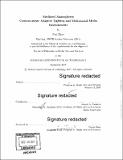Mediated atmospheres : context-aware adaptive lighting and multimodal media environments
Author(s)
Zhao, Nan
DownloadFull printable version (20.31Mb)
Alternative title
Context-aware adaptive lighting and multimodal media environments
Other Contributors
Program in Media Arts and Sciences (Massachusetts Institute of Technology)
Advisor
Joseph A. Paradiso..
Terms of use
Metadata
Show full item recordAbstract
This dissertation introduces a controller for a context-aware office space that seamlessly and continuously transforms itself to support the activities of its occupants. Properties of the workspace, such as light, sound, textures and objects, have a remarkable influence on the human body, with measurable effects on physiology, cognition, and emotion. New control capabilities, e.g. wireless-controlled lighting and digital media displays, offer an opportunity to dynamically enhance the workspace for recreation, creativity, and productivity, in unison with the occupant's activities. Besides benefits for work engagement, personalized control could optimize for energy efficiency and foster Loose Fit planning to maximize flexible use of limited space. Accordingly, this controller incorporates sensing and computation to mediate between occupants' actions and the adaptive environment in a closed-loop fashion, producing what I call Mediated Atmospheres - seamless transitions of harmonious compositions of (1) light and (2) multimodal media. Through a series of studies, I evaluated this controller and demonstrated its potential to improve the workspace. Improvements were observed in energy savings (52% estimated energy savings compared to static illumination), significant (p < 0.05) increases of perceived fitness for focus and stress restoration, and significant (p < 0.05) physiological changes towards preferred conditions, e.g. in heart rate variability and facial expression. Furthermore, this work discusses the effects of adaptation as a form of behavioral feedback and raises broadly applicable questions about how to best balance automatic control and manual preference setting. The controller, in its core, builds on two contextual control dimensions, Focus and Restoration, which were experimentally discovered. They establish a lower dimensional representation (control map) that facilitates continuous mapping of the sensing and adaptive capabilities. Each unique space produces a new control map, which I computed using either subjective ratings, image analysis or physiological monitoring of the occupant. I performed an in-depth comparison of the image and rating approach for lighting and found that image analysis of either photographs or 3D renderings can accelerate the mapping process by reducing the amount of required human input. This finding allows us to generalize the subjective rating approach, and for the first time enables practicing designers to quickly link the positioning of lighting instruments to perceptual models of space.
Description
Thesis: Ph. D., Massachusetts Institute of Technology, School of Architecture and Planning, Program in Media Arts and Sciences, 2017. Cataloged from PDF version of thesis. Includes bibliographical references (pages 161-172).
Date issued
2017Department
Program in Media Arts and Sciences (Massachusetts Institute of Technology)Publisher
Massachusetts Institute of Technology
Keywords
Program in Media Arts and Sciences ()